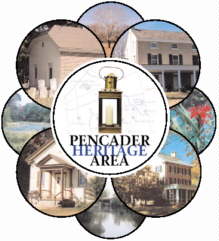 The Cann House was built circa 1835 by William Cann. Located on the West side of Summit Bridge Road (old Rt. 896) south of Glasgow, the front of the house faces south, not east towards the road. It was originally built to face the New Castle and Frenchtown Railroad, which was in operation from 1832 to 1853. The railroad line that ran east and west from New Castle, Delaware to Frenchtown Maryland was just a few feet from the front of the house; a ghost of the old tracks can still be seen in the front yard. It is believed that the house was used as a station for the New Castle and Frenchtown Railroad.
The Cann House was built circa 1835 by William Cann. Located on the West side of Summit Bridge Road (old Rt. 896) south of Glasgow, the front of the house faces south, not east towards the road. It was originally built to face the New Castle and Frenchtown Railroad, which was in operation from 1832 to 1853. The railroad line that ran east and west from New Castle, Delaware to Frenchtown Maryland was just a few feet from the front of the house; a ghost of the old tracks can still be seen in the front yard. It is believed that the house was used as a station for the New Castle and Frenchtown Railroad.
The pre-Georgian structure provided an exterior access for each room on the first floor. The original two-story structure is stuccoed brick block, with brick chimneys rising out of each gable end wall. Two additions have been added in line and connected to the west end of the house.
At the time of William Cann�s death he owned 690 acres in Pencader Hundred most of which, including the house, remained in
the Cann family until 1947 when it was sold by Walter Cann. Walter Cann spent most of his life as a well known Doctor in Pencader
Hundred. William Cann is directly descended from John Cann, who came from Bristol, England in 1682 and became the first Register of Wills in Delaware in 1684. At the time he owned a great deal of land in White Clay Creek and was a member of Council under Penn, 1686-7-8, 1690.
The sixth generation of Cann�s was Richard T. who was a farmer, State Legislator and State Senator, the former in 1908. The 1868 Beers Atlas shows Richard T. Cann owning a large amount of land connected to the Cann House. James Cann is listed on the
same map as owning the mentioned house; he sold it to Richard T. in 1872 who left the farm to Thomas Allibone Cann, the father
of Dr. Walter Cann. Of the many houses owned by the Cann�s, who were prominent Pencader citizens, this house is the only one
that remains.
The house is also historically significant because of its connection with the New Castle and Frenchtown Railroad. Although
the railroad discontinued operation in 1853, it is still mentioned on Deeds of land that connect to its old right-of-way to this day.
|
